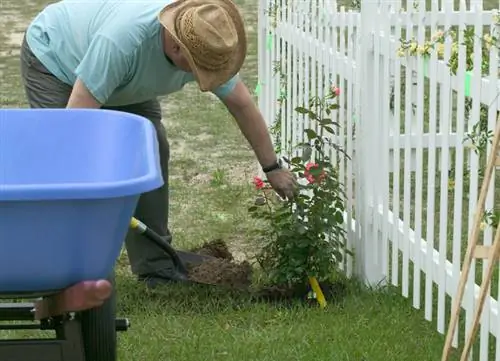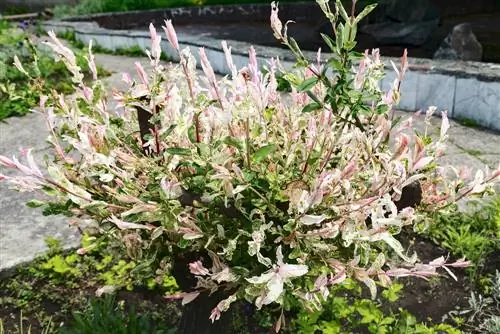- Author admin [email protected].
- Public 2023-12-16 16:46.
- Last modified 2025-06-01 06:02.
The older climbing roses get, the more beautiful and lush they bloom - provided, of course, that the plants are cared for appropriately and rejuvenated from time to time by pruning them appropriately. However, various reasons may make it necessary for such a magnificent specimen to be implemented. We'll explain how this works in this article.

How to plant climbing roses?
To successfully transplant a climbing rose, choose a mild, frost-free fall day, cut the rose back heavily and dig it up deeply. Plant the rose in a new, sunny location, water it well and pile it up.
Choose a suitable location and time
One of the most common reasons for moving older climbing roses is the location. Over time, this may seem unsuitable, be it because the soil is exhausted or other plants (e.g. trees and other woody plants) are now robbing the climbing rose of light and space due to their growth. But why you want to transplant your climbing rose is basically irrelevant, because now only the new location is important. This should:
- If possible, be sunny to light partial shade (depending on the rose variety)
- give the plant enough air, because roses like it airy
- and cannot tolerate heat accumulation
- the soil is at best slightly moist, permeable and nutrient-rich.
The best time to transplant the climbing rose is a mild, frost-free day in autumn or early spring, when the deciduous plant has shed its leaves or has not yet sprouted new ones. However, autumn is preferable for rapid growth.
Do not plant climbing roses in a location where roses have already grown
Roses often do not grow optimally in locations where rose plants (which, by the way, also include apples and pears) have already grown. The exact reason for this is not known, but it is suspected that soil fatigue is to blame. This means that the specific nutrients have been drawn from the soil and are no longer available to the new rose.
Implementing a climbing rose - this is how it’s done
When moving the climbing rose, it is best to proceed as follows:
- First prepare the planting hole at the new location well.
- Prune back the climbing rose to be transplanted.
- Then use the spade to dig a deep trench around the rootstock.
- The deeper it gets, the better! About two spade blade lengths are optimal.
- Roses are deep-rooted, which is why you have to dig as deep as possible.
- Now carefully lever out the plant with a digging fork.
- Cut back bruised and injured roots with clean and sharp scissors.
- Now plant the rose in its new location
- and water them well.
- To protect against drying out, the freshly planted climbing rose should also be piled up.
Tip
Do not add compost to the excavated soil, but rather good rose soil.






